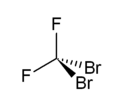Dibromodifluoromethane
 | |
| Names | |
|---|---|
| IUPAC name
Dibromodifluoromethane | |
| Other names
Difluorodibromomethane, Carbon dibromide difluoride, Carbon bromide fluoride, Halon 1202, Fluorocarbon 12-B2, FC 12-B2, R 12B2, UN 1941, Freon 12B2 | |
| Identifiers | |
| 75-61-6 | |
| ChEMBL | ChEMBL499553 |
| ChemSpider | 6142 |
| EC number | 200-885-5 |
| |
| Jmol-3D images | Image |
| PubChem | 6382 |
| RTECS number | PA7525000 |
| |
| Properties | |
| CBr2F2 | |
| Molar mass | 209.82 g/mol |
| Appearance | Colourless gas/liquid |
| Density | 8.7 kg/m3 (for gas)
2.27 g/cm3 (for liquid) |
| Melting point | −101.1 °C (−150.0 °F; 172.1 K) |
| Boiling point | 22.8 °C (73.0 °F; 295.9 K) |
| Insoluble | |
| log P | 1.99 |
| Vapor pressure | 83 kPa at 20 °C |
| Hazards | |
| Main hazards | Dangerous for the environment (N) |
| S-phrases | S23, S24/25 |
| NFPA 704 | |
| Flash point | nonflammable [1] |
| US health exposure limits (NIOSH): | |
| PEL (Permissible) |
TWA 100 ppm (860 mg/m3)[1] |
| REL (Recommended) |
TWA 100 ppm (860 mg/m3)[1] |
| IDLH (Immediate danger) |
2000 ppm[1] |
| Except where noted otherwise, data is given for materials in their standard state (at 25 °C (77 °F), 100 kPa) | |
| | |
| Infobox references | |
Dibromodifluoromethane is a mixed halomethane. It is a colorless non-flammable liquid.
Along with Halons 1211, 2402, and 1301, it is the most effective fire extinguishers, however, also the most toxic one.
It is a class I ozone depleting substance (ODS).
Table of physical properties
| Property | Value |
|---|---|
| Density (ρ) at 15 °C (liquid) | 2.3063 g.cm−3 |
| Critical temperature (Tc) | 198.3 °C (471.3 K) |
| Critical pressure (pc) | 4.13 MPa (40.8 bar) |
| Refractive index (n) at 20 °C, D | 1.398 |
| Dipole moment | 0.7 D |
| Ozone depletion potential (ODP) | 0.4 (CCl3F = 1) |
References
External links
- International Chemical Safety Card 1419
- "NIOSH Pocket Guide to Chemical Hazards #0214". National Institute for Occupational Safety and Health (NIOSH).
- Photolysis of dibromodifluoromethane at 265 nm
- Raman and infrared spectra of solid dibromodifluoromethane
| ||||||||||||||||||||||
